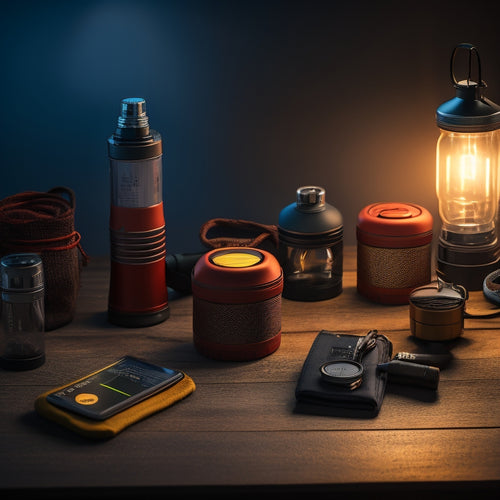
Tiny House Solar System
Share
You're embracing off-grid freedom with a compact 120W solar system, capable of powering essential devices like lights, laptops, and small appliances, while reducing your reliance on noisy fuel systems and high energy costs. This setup provides energy independence and self-sufficient living, but requires efficient energy storage and management for peak performance. By monitoring your energy consumption, you'll identify areas for improvement, reducing your carbon footprint and energy bills. As you investigate your tiny house solar system, you'll reveal the importance of refined charge controllers, daily energy management, and maximizing solar energy harvest, and realize how to access even more benefits from your sustainable living solution.
The Essentials
- A 120W solar system provides off-grid freedom, powering essential devices like lights, laptops, and small appliances while reducing energy costs and carbon footprint.
- Energy independence is achieved by storing excess energy for use during low sunlight periods, allowing for reliable power supply and reduced grid dependency.
- Efficient energy storage and management are crucial for optimal performance, with smart systems tracking energy consumption to promote habit adjustments and reduced energy waste.
- A tiny house solar system requires a well-designed charge controller, utilizing MPPT technology to maximize energy harvesting and reduce heat generation for improved overall performance.
- Daily energy management involves assessing energy consumption patterns, identifying inefficiencies, and implementing lifestyle adjustments to reduce energy demands and optimize system design.
Off-Grid Freedom in 120W
You're about to experience off-grid freedom with a 120W solar system that powers your tiny essentials, including lights, laptops, and small appliances.
By breaking free from the grid, you'll solve the problems of high energy costs, noisy fuel-based systems, and limited access to power in remote areas Renewable Energy Systems.
This compact system provides energy independence now, letting you live life on your own terms.
Powering Tiny Essentials
Living off-grid in a tiny house requires a reliable power supply to support daily essentials. You'll need to power tiny appliances, essential devices, and solar gadgets that make life comfortable.
Energy storage and power management are vital to guarantee your system runs efficiently. A well-designed battery system will store excess energy generated by your solar panels during the day for use at night or on cloudy days.
With a focus on self-sufficient energy, you can confirm that your tiny house is powered by renewable energy solutions. By investing in energy storage batteries and solar inverters, you can enjoy off-grid freedom and independence.
Your lighting solutions should be energy-efficient, and portable chargers can come in handy for charging small devices on-the-go. Smart systems can help you monitor your energy usage and adjust your habits accordingly.
With energy monitoring, you can track your consumption and identify areas for improvement. This data will help you optimize your power management strategy and make the most of your 120W solar system.
Energy Independence Now
Achieving energy independence in your tiny house is now within reach with a 120W solar system. You're on the path to breaking free from the grid and relying solely on renewable resources, such as off-grid solar systems that provide a self-sufficient source of energy.
This compact system is designed to meet your essential energy needs, providing you with the freedom to live off-grid. Additionally, with the ability to store excess energy generated during the day, you'll have a steady supply of power even on cloudy days or during periods of low sunlight.
With a 120W solar system, you'll be able to utilize enough energy to power your lights, laptop, and other small appliances. This system is perfect for tiny house dwellers who want to reduce their carbon footprint and reliance on public utilities.
By leveraging renewable resources, you'll considerably lower your energy costs and environmental impact. With energy independence, you'll have the freedom to live wherever you want, without being tied to the grid.
Say goodbye to utility bills and hello to off-grid freedom!
Reduced Carbon Footprint Guaranteed
You're switching to an eco-friendly energy source with your tiny house solar system, which means you'll greatly reduce your reliance on fossil fuels.
By utilizing photovoltaic cells, you'll generate clean energy and minimize your impact on the environment.
Additionally, with a residential solar energy system, you can reduce your energy bills and carbon footprint.
As a result, you'll produce minimal emissions, guaranteeing a smaller carbon footprint.
With this system, you can rest assured that you're doing your part to minimize your impact on the environment.
Eco-Friendly Energy Source
Frequently, tiny house owners opt for solar power systems as an eco-friendly energy source, reducing their reliance on traditional grid electricity and minimizing their carbon footprint.
By utilizing renewable energy from the sun, you'll be embracing sustainable living and contributing less to environmental impact.
When selecting a solar installation, you'll encounter various solar panel types, each with its unique characteristics and benefits.
You'll want to evaluate energy storage solutions to guarantee a steady supply of power, even on cloudy days or during the night.
This green technology integration will enable you to live off the grid, enjoying the freedom that comes with it.
As you investigate eco-friendly solutions, remember that solar energy benefits extend beyond reducing your carbon footprint.
You'll also be saving money on energy costs and increasing your tiny house's value.
Minimal Emissions Guaranteed
By utilizing solar energy, you're greatly reducing your reliance on fossil fuels, which are the primary contributors to greenhouse gas emissions. As a result, you're making a significant impact on the environment by adopting sustainable practices.
With a tiny house solar system, you're guaranteed to minimize your carbon footprint, contributing less to climate change and air pollution.
By utilizing renewable resources, you're also reducing your dependence on the grid, which is often powered by non-renewable energy sources. This means you're not only lowering your emissions but also reducing your energy costs.
A tiny house solar system is designed to provide you with a reliable and consistent energy supply, regardless of your location or grid connectivity.
With a minimal emissions guarantee, you can enjoy the freedom to live off-grid, without compromising on your energy needs. Your tiny house solar system will provide you with a clean, sustainable, and renewable source of energy, giving you the independence you desire.
Efficient Charge Controller Design
You'll want to guarantee your tiny house solar system's charge controller is optimized for efficient power conversion, which is where MPPT (Maximum Power Point Tracking) technology comes in.
By utilizing MPPT, you can maximize energy harvesting from your solar panels, even in varying environmental conditions. For instance, when paired with off-grid systems, MPPT technology can greatly improve the overall performance of your renewable energy storage system.
This technology's advantages, combined with efficient power conversion, will considerably impact your system's overall performance and energy independence.
MPPT Technology Advantages
Within a tiny house solar system, the charge controller plays a vital role in guaranteeing that your batteries are charged efficiently and safely.
That's why you should consider a Maximum Power Point Tracking (MPPT) charge controller, which offers several advantages over traditional PWM controllers. MPPT technology allows you to utilize more power from your solar panels, resulting in faster charging times and increased energy yield.
The benefits of MPPT include up to 30% more power harvesting, reduced heat generation, and a wider range of compatible solar panel configurations.
When selecting an MPPT charge controller, look for features like high-efficiency power conversion, automatic voltage detection, and built-in monitoring capabilities.
MPPT applications are diverse, ranging from small-scale off-grid systems to large commercial installations.
By understanding the myths and misconceptions surrounding MPPT, you can make an informed decision about your tiny house solar system.
Proper installation, maintenance, and troubleshooting are essential to guarantee peak MPPT performance and efficiency.
Efficient Power Conversion
In the heart of your tiny house solar system, a high-efficiency charge controller is vital for maximizing power conversion. You want to make certain that the energy generated by your solar panels is converted into usable power for your tiny home. A high-efficiency charge controller plays a critical role in this process.
When selecting a charge controller, look for one with a high conversion efficiency rating. This will minimize energy losses during the conversion process, guaranteeing you get the most out of your solar panel's energy output. Some charge controllers boast efficiencies of up to 98%, considerably reducing energy waste.
To achieve peak energy conversion, you'll want to take into account advanced energy conversion methods, such as pulse-width modulation (PWM) or maximum power point tracking (MPPT).
These methods help to enhance solar panel efficiency by tracking the maximum power point of your solar array and adjusting the energy conversion accordingly. By incorporating a high-efficiency charge controller with advanced energy conversion methods, you'll be able to utilize the full potential of your solar panel system, giving you the freedom to live off the grid.
Assess Your Energy Demands
You need to determine your daily energy usage to size your tiny house solar system correctly. To do this, you'll want to calculate your overall energy consumption in watt-hours (Wh) per day, taking into consideration appliances, lighting, and other devices.
As you consider your energy needs, keep in mind the benefits of off-grid living and the importance of an efficient renewable energy solution for your tiny home.
Understanding your energy consumption patterns, including peak usage times and seasonal variations, will also help you design an efficient and reliable solar system.
Daily Energy Usage
Your daily energy usage sets the foundation for designing an effective tiny house solar system. To optimize your energy usage, it is crucial to monitor and understand your daily energy demands. This involves tracking your energy consumption patterns, identifying areas of inefficiency, and implementing usage optimization strategies.
| Appliance | Daily Energy Usage (Wh) |
|---|---|
| Refrigerator | 1200 |
| Lighting | 400 |
| Laptop | 200 |
| Water Pump | 300 |
| Ventilation Fan | 150 |
Energy Consumption Patterns
Daily energy usage patterns are a critical component in designing an effective tiny house solar system. To optimize your energy usage, you'll need to assess your consumption habits and identify areas for improvement.
Start by tracking your daily energy usage to understand your load analysis and usage patterns. This will help you pinpoint opportunities for efficiency strategies, such as making lifestyle adjustments to reduce your energy demands.
By analyzing your energy usage, you can identify behavioral changes that'll lead to significant energy savings. For instance, you might consider adjusting your lighting habits, using energy-efficient appliances, or implementing power management techniques.
These small changes can add up to make a big impact on your energy consumption.
Higher Efficiency MPPT Tech
You'll want to maximize energy harvest by optimizing your MPPT (Maximum Power Point Tracking) technology, as it directly impacts the performance of your tiny house solar system.
Higher efficiency MPPT tech allows your system to track the maximum power point of your solar array, ensuring you're generating the most power possible.
Maximizing Energy Harvest
Optimization is key when it comes to utilizing the full potential of your tiny house solar system. To maximize energy harvest, you need to evaluate several factors.
First, guarantee ideal solar panel orientation to capture sunlight exposure. This analysis will help you determine the best angle and direction for your panels.
Next, select energy storage solutions that match your battery capacity planning, considering seasonal energy variations. Regular solar system maintenance is also essential to prevent energy losses.
When evaluating your system's performance, reflect on weather impact and load management strategies to enhance energy usage.
Inverter selection tips can also help you make the most of your system's energy output. If you're connected to the grid, investigate grid connection options to sell excess energy back to the utility company.
Frequently Asked Questions
Can a Tiny House Solar System Be Installed on a Moving Vehicle?
When you're considering a mobile solar setup, you'll need to assess vehicle compatibility and investigate solar panel options that can withstand vibrations, wind, and varying temperatures to guarantee a reliable energy supply on the move.
Are Tiny House Solar Systems Compatible With All Battery Types?
You're not stuck between a rock and a hard place when it comes to battery compatibility - most solar systems can adapt to various battery types, ensuring seamless integration and ideal solar efficiency, giving you the freedom to roam.
How Long Does It Take to Install a Tiny House Solar System?
When planning your off-grid escape, you'll wonder how long installation takes. Typically, it's 2-5 days, depending on the complexity of your setup and solar panel types, but a professional can provide a more precise installation timeline for your unique needs.
Can I Expand My Tiny House Solar System in the Future?
As you chart your course for energy independence, you'll be relieved to know that you can future-proof your system, scaling up or integrating new components seamlessly, allowing you to utilize more power and adapt to future upgrades with ease.
Are Tiny House Solar Systems Resistant to Extreme Weather Conditions?
When you invest in a solar system, you'll want to guarantee it can withstand extreme weather conditions. You'll need to prioritize weather durability through proper system maintenance, like securing panels and regular inspections, so you can enjoy reliable energy and live freely off the grid.
Final Thoughts
As you step into your tiny house, you're wrapped in the comfort of off-grid freedom. Your 120W solar system hums quietly, feeding your energy demands while slashing your carbon footprint. The efficient charge controller design guarantees maximum juice from every sunbeam. With MPPT tech, you're utilizing every watt. You've assessed your energy needs, and now you're living the dream – sustainable, self-sufficient, and serene.
Related Posts
-

How to Achieve a Zero-Waste Lifestyle for a Greener Tomorrow
To achieve a zero-waste lifestyle, start by adopting the principles of refusing, reducing, reusing, and recycling. Sw...
-

Best Solar Powered Flashlights for Emergency Situations
When you're choosing the best solar-powered flashlights for emergency situations, focus on their brightness, battery ...
-

Smart Grid Technology Implementation Challenges
You'll encounter several challenges when implementing smart grid technology, particularly in cost management, scalabi...


